RNA沉默在植物逆境生物中的作用
分子生物学知识:RNA干扰技术在植物和动物基因沉默上的应用
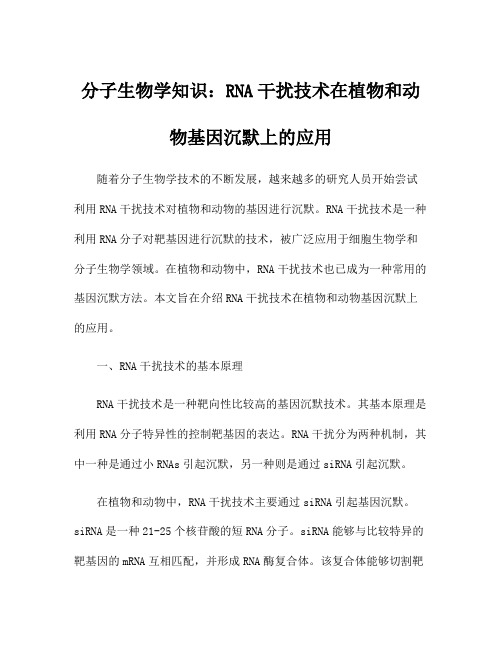
分子生物学知识:RNA干扰技术在植物和动物基因沉默上的应用随着分子生物学技术的不断发展,越来越多的研究人员开始尝试利用RNA干扰技术对植物和动物的基因进行沉默。
RNA干扰技术是一种利用RNA分子对靶基因进行沉默的技术,被广泛应用于细胞生物学和分子生物学领域。
在植物和动物中,RNA干扰技术也已成为一种常用的基因沉默方法。
本文旨在介绍RNA干扰技术在植物和动物基因沉默上的应用。
一、RNA干扰技术的基本原理RNA干扰技术是一种靶向性比较高的基因沉默技术。
其基本原理是利用RNA分子特异性的控制靶基因的表达。
RNA干扰分为两种机制,其中一种是通过小RNAs引起沉默,另一种则是通过siRNA引起沉默。
在植物和动物中,RNA干扰技术主要通过siRNA引起基因沉默。
siRNA是一种21-25个核苷酸的短RNA分子。
siRNA能够与比较特异的靶基因的mRNA互相匹配,并形成RNA酶复合体。
该复合体能够切割靶基因的mRNA,从而导致靶基因的表达下降或者消失,这就是RNA干扰技术的基本原理。
二、RNA干扰技术在植物基因沉默中的应用在植物中,RNA干扰技术是一种有效的基因沉默方法。
利用RNA干扰技术可以沉默某些不需要或者不希望表达的基因,也可以帮助解析基因调控网络。
在植物中,RNA干扰技术主要通过两种方法实现,一种是利用植物自身的RNA干扰系统,另一种则是人工引入RNA干扰载体。
1.利用植物自身的RNA干扰系统植物本身就具有自身的RNA干扰机制。
植物中RNA干扰的效率一般比较低,但是其操作便捷,可以直接在目标植物中进行操作。
治理植物病害和提高植物营养品质的方面,RNA干扰在植物的生命科学中具有重要地位。
2.人工引入RNA干扰载体利用人工合成的RNA干扰载体是一种常用的方法。
通过植物转化技术把RNA载体导入植物体内,该载体会在植物体内引发RNA干扰反应,从而沉默目标基因。
利用基因工程的方法,科学家可以在RNA干扰载体中加入目标基因的核酸序列,这样当RNA干扰载体与细胞核染色体以及相关蛋白结合后,RNA将能够特异性地与靶标基因的mRNA相结合,导致该基因的沉默。
RNA沉默技术及其在植物中的应用
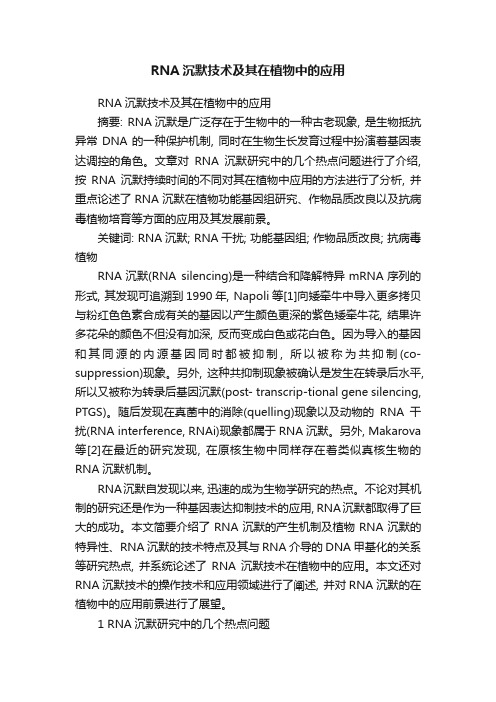
RNA沉默技术及其在植物中的应用RNA沉默技术及其在植物中的应用摘要: RNA沉默是广泛存在于生物中的一种古老现象, 是生物抵抗异常DNA的一种保护机制, 同时在生物生长发育过程中扮演着基因表达调控的角色。
文章对RNA沉默研究中的几个热点问题进行了介绍, 按RNA沉默持续时间的不同对其在植物中应用的方法进行了分析, 并重点论述了RNA沉默在植物功能基因组研究、作物品质改良以及抗病毒植物培育等方面的应用及其发展前景。
关键词: RNA沉默; RNA干扰; 功能基因组; 作物品质改良; 抗病毒植物RNA沉默(RNA silencing)是一种结合和降解特异mRNA序列的形式, 其发现可追溯到1990年, Napoli等[1]向矮牵牛中导入更多拷贝与粉红色色素合成有关的基因以产生颜色更深的紫色矮牵牛花, 结果许多花朵的颜色不但没有加深, 反而变成白色或花白色。
因为导入的基因和其同源的内源基因同时都被抑制, 所以被称为共抑制(co-suppression)现象。
另外, 这种共抑制现象被确认是发生在转录后水平, 所以又被称为转录后基因沉默(post- transcrip-tional gene silencing, PTGS)。
随后发现在真菌中的消除(quelling)现象以及动物的RNA干扰(RNA interference, RNAi)现象都属于RNA沉默。
另外, Makarova 等[2]在最近的研究发现, 在原核生物中同样存在着类似真核生物的RNA沉默机制。
RNA沉默自发现以来, 迅速的成为生物学研究的热点。
不论对其机制的研究还是作为一种基因表达抑制技术的应用, RNA沉默都取得了巨大的成功。
本文简要介绍了RNA沉默的产生机制及植物RNA沉默的特异性、RNA沉默的技术特点及其与RNA介导的DNA甲基化的关系等研究热点, 并系统论述了RNA沉默技术在植物中的应用。
本文还对RNA沉默技术的操作技术和应用领域进行了阐述, 并对RNA沉默的在植物中的应用前景进行了展望。
RNA干扰技术在植物保护中的应用
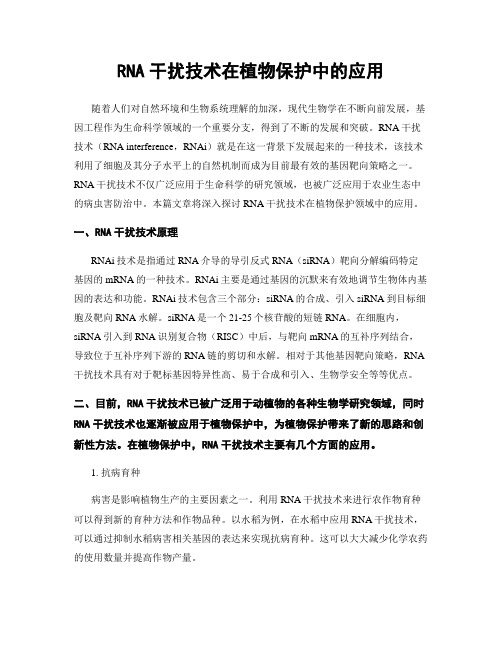
RNA干扰技术在植物保护中的应用随着人们对自然环境和生物系统理解的加深,现代生物学在不断向前发展,基因工程作为生命科学领域的一个重要分支,得到了不断的发展和突破。
RNA干扰技术(RNA interference,RNAi)就是在这一背景下发展起来的一种技术,该技术利用了细胞及其分子水平上的自然机制而成为目前最有效的基因靶向策略之一。
RNA干扰技术不仅广泛应用于生命科学的研究领域,也被广泛应用于农业生态中的病虫害防治中。
本篇文章将深入探讨RNA干扰技术在植物保护领域中的应用。
一、RNA干扰技术原理RNAi技术是指通过RNA介导的导引反式RNA(siRNA)靶向分解编码特定基因的mRNA的一种技术。
RNAi主要是通过基因的沉默来有效地调节生物体内基因的表达和功能。
RNAi技术包含三个部分:siRNA的合成、引入siRNA到目标细胞及靶向RNA水解。
siRNA是一个21-25个核苷酸的短链RNA。
在细胞内,siRNA引入到RNA识别复合物(RISC)中后,与靶向mRNA的互补序列结合,导致位于互补序列下游的RNA链的剪切和水解。
相对于其他基因靶向策略,RNA 干扰技术具有对于靶标基因特异性高、易于合成和引入、生物学安全等等优点。
二、目前,RNA干扰技术已被广泛用于动植物的各种生物学研究领域,同时RNA干扰技术也逐渐被应用于植物保护中,为植物保护带来了新的思路和创新性方法。
在植物保护中,RNA干扰技术主要有几个方面的应用。
1. 抗病育种病害是影响植物生产的主要因素之一。
利用RNA干扰技术来进行农作物育种可以得到新的育种方法和作物品种。
以水稻为例,在水稻中应用RNA干扰技术,可以通过抑制水稻病害相关基因的表达来实现抗病育种。
这可以大大减少化学农药的使用数量并提高作物产量。
2. 植物抗逆性研究对于环境和自然界中各种逆境(例如高盐度、低温等)的响应是植物生长过程中十分重要的一环。
RNA干扰技术可以用于研究植物响应逆境所需要的基因,从而更好地了解和调控植物的抗逆性。
RNA沉默——精选推荐
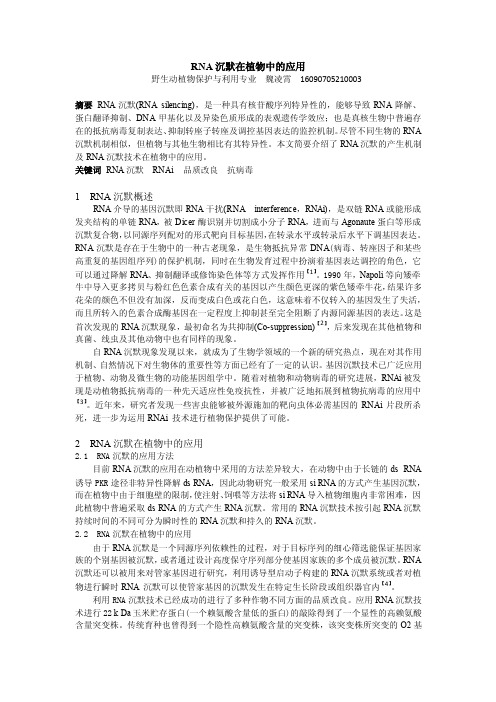
RNA沉默在植物中的应用野生动植物保护与利用专业魏凌霄16090705210003摘要RNA沉默(RNA silencing),是一种具有核苷酸序列特异性的,能够导致RNA降解、蛋白翻译抑制、DNA甲基化以及异染色质形成的表观遗传学效应;也是真核生物中普遍存在的抵抗病毒复制表达、抑制转座子转座及调控基因表达的监控机制。
尽管不同生物的RNA 沉默机制相似,但植物与其他生物相比有其特异性。
本文简要介绍了RNA沉默的产生机制及RNA沉默技术在植物中的应用。
关键词RNA沉默RNAi 品质改良抗病毒1 RNA沉默概述RNA介导的基因沉默即RNA干扰(RNA interference,RNAi),是双链RNA或能形成发夹结构的单链RNA,被Dicer酶识别并切割成小分子RNA,进而与Agonaute蛋白等形成沉默复合物,以同源序列配对的形式靶向目标基因,在转录水平或转录后水平下调基因表达。
RNA沉默是存在于生物中的一种古老现象,是生物抵抗异常DNA(病毒、转座因子和某些高重复的基因组序列)的保护机制,同时在生物发育过程中扮演着基因表达调控的角色,它可以通过降解RNA、抑制翻译或修饰染色体等方式发挥作用【1】。
1990年,Napoli等向矮牵牛中导入更多拷贝与粉红色色素合成有关的基因以产生颜色更深的紫色矮牵牛花,结果许多花朵的颜色不但没有加深,反而变成白色或花白色,这意味着不仅转入的基因发生了失活,而且所转入的色素合成酶基因在一定程度上抑制甚至完全阻断了内源同源基因的表达。
这是首次发现的RNA沉默现象,最初命名为共抑制(Co-suppression)【2】,后来发现在其他植物和真菌、线虫及其他动物中也有同样的现象。
自RNA沉默现象发现以来,就成为了生物学领域的一个新的研究热点,现在对其作用机制、自然情况下对生物体的重要性等方面已经有了一定的认识。
基因沉默技术已广泛应用于植物、动物及微生物的功能基因组学中。
随着对植物和动物病毒的研究进展,RNAi被发现是动植物抵抗病毒的一种先天适应性免疫抗性,并被广泛地拓展到植物抗病毒的应用中【3】。
植物RNA修饰与环境逆境响应
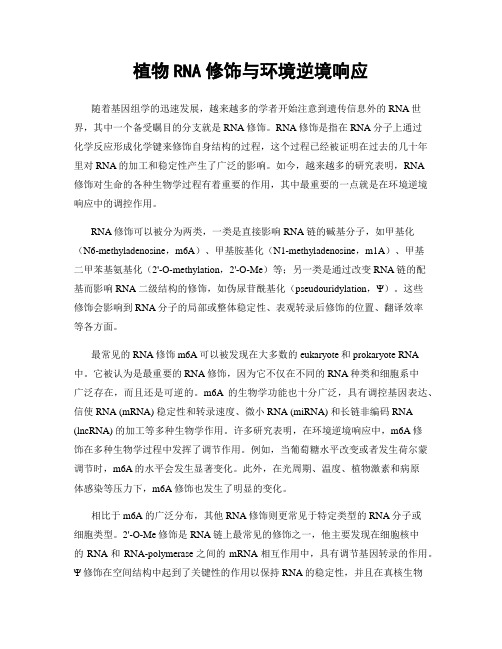
植物RNA修饰与环境逆境响应随着基因组学的迅速发展,越来越多的学者开始注意到遗传信息外的RNA世界,其中一个备受瞩目的分支就是RNA修饰。
RNA修饰是指在RNA分子上通过化学反应形成化学键来修饰自身结构的过程,这个过程已经被证明在过去的几十年里对RNA的加工和稳定性产生了广泛的影响。
如今,越来越多的研究表明,RNA修饰对生命的各种生物学过程有着重要的作用,其中最重要的一点就是在环境逆境响应中的调控作用。
RNA修饰可以被分为两类,一类是直接影响RNA链的碱基分子,如甲基化(N6-methyladenosine,m6A)、甲基胺基化(N1-methyladenosine,m1A)、甲基二甲苯基氨基化(2'-O-methylation,2'-O-Me)等;另一类是通过改变RNA链的配基而影响RNA二级结构的修饰,如伪尿苷酰基化(pseudouridylation,Ψ)。
这些修饰会影响到RNA分子的局部或整体稳定性、表观转录后修饰的位置、翻译效率等各方面。
最常见的RNA修饰m6A可以被发现在大多数的eukaryote和prokaryote RNA 中。
它被认为是最重要的RNA修饰,因为它不仅在不同的RNA种类和细胞系中广泛存在,而且还是可逆的。
m6A的生物学功能也十分广泛,具有调控基因表达、信使RNA (mRNA) 稳定性和转录速度、微小RNA (miRNA) 和长链非编码RNA (lncRNA) 的加工等多种生物学作用。
许多研究表明,在环境逆境响应中,m6A修饰在多种生物学过程中发挥了调节作用。
例如,当葡萄糖水平改变或者发生荷尔蒙调节时,m6A的水平会发生显著变化。
此外,在光周期、温度、植物激素和病原体感染等压力下,m6A修饰也发生了明显的变化。
相比于m6A的广泛分布,其他RNA修饰则更常见于特定类型的RNA分子或细胞类型。
2'-O-Me修饰是RNA链上最常见的修饰之一,他主要发现在细胞核中的RNA和RNA-polymerase之间的mRNA相互作用中,具有调节基因转录的作用。
植物RNA介导基因沉默的生物学研究
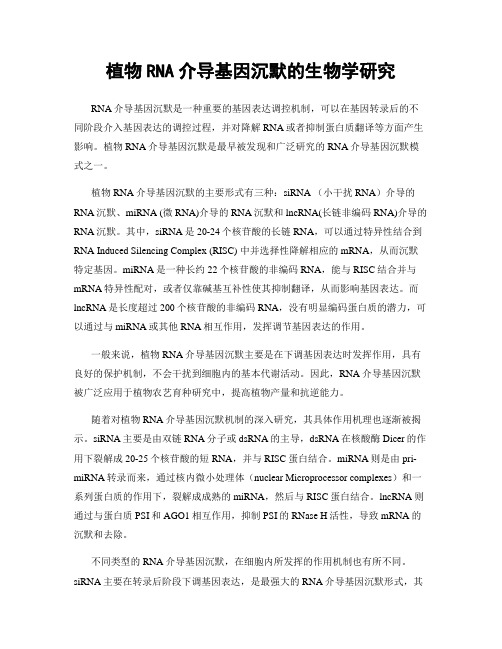
植物RNA介导基因沉默的生物学研究RNA介导基因沉默是一种重要的基因表达调控机制,可以在基因转录后的不同阶段介入基因表达的调控过程,并对降解RNA或者抑制蛋白质翻译等方面产生影响。
植物RNA介导基因沉默是最早被发现和广泛研究的RNA介导基因沉默模式之一。
植物RNA介导基因沉默的主要形式有三种:siRNA (小干扰RNA)介导的RNA沉默、miRNA (微RNA)介导的RNA沉默和lncRNA(长链非编码RNA)介导的RNA沉默。
其中,siRNA是20-24个核苷酸的长链RNA,可以通过特异性结合到RNA Induced Silencing Complex (RISC) 中并选择性降解相应的mRNA,从而沉默特定基因。
miRNA是一种长约22个核苷酸的非编码RNA,能与RISC结合并与mRNA特异性配对,或者仅靠碱基互补性使其抑制翻译,从而影响基因表达。
而lncRNA是长度超过200个核苷酸的非编码RNA,没有明显编码蛋白质的潜力,可以通过与miRNA或其他RNA相互作用,发挥调节基因表达的作用。
一般来说,植物RNA介导基因沉默主要是在下调基因表达时发挥作用,具有良好的保护机制,不会干扰到细胞内的基本代谢活动。
因此,RNA介导基因沉默被广泛应用于植物农艺育种研究中,提高植物产量和抗逆能力。
随着对植物RNA介导基因沉默机制的深入研究,其具体作用机理也逐渐被揭示。
siRNA主要是由双链RNA分子或dsRNA的主导,dsRNA在核酸酶Dicer的作用下裂解成20-25个核苷酸的短RNA,并与RISC蛋白结合。
miRNA则是由pri-miRNA转录而来,通过核内微小处理体(nuclear Microprocessor complexes)和一系列蛋白质的作用下,裂解成成熟的miRNA,然后与RISC蛋白结合。
lncRNA则通过与蛋白质PSI和AGO1相互作用,抑制PSI的RNase H活性,导致mRNA的沉默和去除。
微小RNA在植物逆境响应中的作用研究
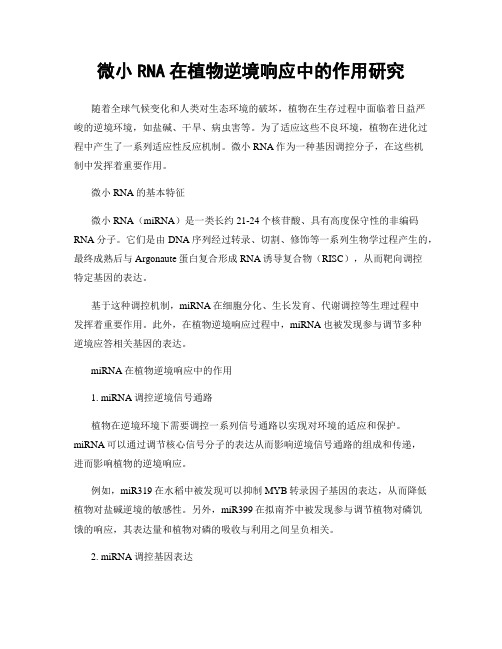
微小RNA在植物逆境响应中的作用研究随着全球气候变化和人类对生态环境的破坏,植物在生存过程中面临着日益严峻的逆境环境,如盐碱、干旱、病虫害等。
为了适应这些不良环境,植物在进化过程中产生了一系列适应性反应机制。
微小RNA作为一种基因调控分子,在这些机制中发挥着重要作用。
微小RNA的基本特征微小RNA(miRNA)是一类长约21-24个核苷酸、具有高度保守性的非编码RNA分子。
它们是由DNA序列经过转录、切割、修饰等一系列生物学过程产生的,最终成熟后与Argonaute蛋白复合形成RNA诱导复合物(RISC),从而靶向调控特定基因的表达。
基于这种调控机制,miRNA在细胞分化、生长发育、代谢调控等生理过程中发挥着重要作用。
此外,在植物逆境响应过程中,miRNA也被发现参与调节多种逆境应答相关基因的表达。
miRNA在植物逆境响应中的作用1. miRNA调控逆境信号通路植物在逆境环境下需要调控一系列信号通路以实现对环境的适应和保护。
miRNA可以通过调节核心信号分子的表达从而影响逆境信号通路的组成和传递,进而影响植物的逆境响应。
例如,miR319在水稻中被发现可以抑制MYB转录因子基因的表达,从而降低植物对盐碱逆境的敏感性。
另外,miR399在拟南芥中被发现参与调节植物对磷饥饿的响应,其表达量和植物对磷的吸收与利用之间呈负相关。
2. miRNA调控基因表达miRNA可以进一步调节逆境适应相关基因的表达,影响植物的生长发育和逆境响应。
例如,miR156在水稻中调节SPL基因家族的表达,进而影响植物的花期、延长植株生长期等。
此外,miRNA还可以在逆境环境下发挥重要的抗氧化作用。
例如,miR398在拟南芥中参与调解响应过氧化物的信号通路,从而减轻植物受到的氧化压力。
3. miRNA参与转录后基因沉默在植物的逆境响应过程中,一些基因可能会发生临时性的转录后调控。
miRNA 参与了基因转录后沉默(TGS)和转录后剪接(TAS)等过程,从而对逆境响应相关基因的表达进行控制。
植物RNA干扰调节机制及其在抗逆过程中的作用
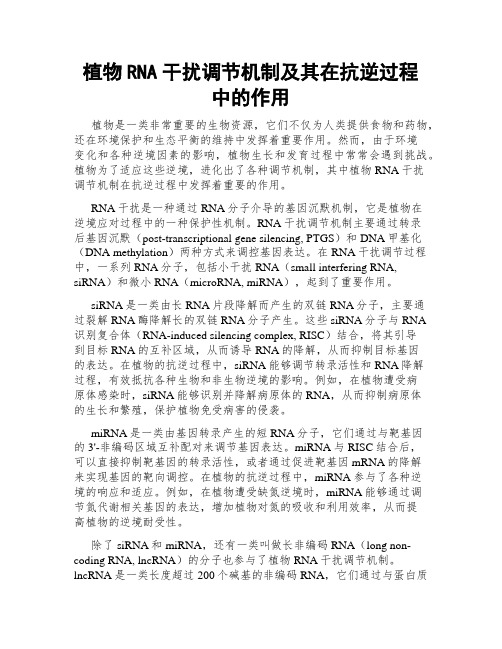
植物RNA干扰调节机制及其在抗逆过程中的作用植物是一类非常重要的生物资源,它们不仅为人类提供食物和药物,还在环境保护和生态平衡的维持中发挥着重要作用。
然而,由于环境变化和各种逆境因素的影响,植物生长和发育过程中常常会遇到挑战。
植物为了适应这些逆境,进化出了各种调节机制,其中植物RNA干扰调节机制在抗逆过程中发挥着重要的作用。
RNA干扰是一种通过RNA分子介导的基因沉默机制,它是植物在逆境应对过程中的一种保护性机制。
RNA干扰调节机制主要通过转录后基因沉默(post-transcriptional gene silencing, PTGS)和DNA甲基化(DNA methylation)两种方式来调控基因表达。
在RNA干扰调节过程中,一系列RNA分子,包括小干扰RNA(small interfering RNA, siRNA)和微小RNA(microRNA, miRNA),起到了重要作用。
siRNA是一类由长RNA片段降解而产生的双链RNA分子,主要通过裂解RNA酶降解长的双链RNA分子产生。
这些siRNA分子与RNA识别复合体(RNA-induced silencing complex, RISC)结合,将其引导到目标RNA的互补区域,从而诱导RNA的降解,从而抑制目标基因的表达。
在植物的抗逆过程中,siRNA能够调节转录活性和RNA降解过程,有效抵抗各种生物和非生物逆境的影响。
例如,在植物遭受病原体感染时,siRNA能够识别并降解病原体的RNA,从而抑制病原体的生长和繁殖,保护植物免受病害的侵袭。
miRNA是一类由基因转录产生的短RNA分子,它们通过与靶基因的3'-非编码区域互补配对来调节基因表达。
miRNA与RISC结合后,可以直接抑制靶基因的转录活性,或者通过促进靶基因mRNA的降解来实现基因的靶向调控。
在植物的抗逆过程中,miRNA参与了各种逆境的响应和适应。
例如,在植物遭受缺氮逆境时,miRNA能够通过调节氮代谢相关基因的表达,增加植物对氮的吸收和利用效率,从而提高植物的逆境耐受性。
小RNA在植物逆境响应中的作用及机制研究

小RNA在植物逆境响应中的作用及机制研究随着全球气候变化以及自然环境的日益恶化,植物生长与发育面临着更加复杂多变的环境压力,比如干旱、高温、低温、盐碱、重金属等逆境条件,这些逆境条件的影响导致了植物减少了产量及质量,对农业生产及人类生存产生了深远的影响。
因此,研究植物对逆境的响应机制,为农业生产及环境保护具有十分重要的意义。
近年来,小RNA作为重要的生物调控因子逐渐成为了研究逆境响应的热点。
一、小RNA的基本概念和类别小RNA是一类长度约为18~30 nt的非编码RNA,是一个重要且复杂的基因调控系统,负责调控许多生命过程。
小RNA可以分为多种类型,其中较为常见和重要的包括:siRNA(小干扰RNA)、miRNA(microRNA)和piRNA(piwi-interacting RNA)等,这些小RNA都在基因表达调控、细胞发育、胁迫应答以及基因表观遗传学方面发挥着重要的调控作用。
二、小RNA在植物逆境响应中的基本作用小RNA参与植物应对各种逆境条件的途径具有多样性。
例如:1. 调控基因表达miRNA和siRNA的主要功能均为通过剪切蛋白质编码基因的mRNA,降低目标蛋白质的表达。
在植物逆境响应中,许多与应激相关的基因受到小RNA的调控。
若干miRNA对于调节植物的响应与适应反应是重要的。
目前在逆境期间,miRNA在应激响应中的作用已被广泛研究并发现存在于各种植物中。
2. 反应逆境刺激信号siRNA在植物逆境中扮演了重要的抗逆应答调节角色,可以使细胞易感性基因表达水平发生改变,进而诱导抗寒蛋白、抗旱蛋白等抗逆蛋白的合成,增强植物对逆境的抵御能力。
3. 参与基因插入和基因沉默siRNA不仅可以诱导异染色质的形成并导致基因富集区域被称为沉默,而且还参与植物对各种逆境应答的基因插入和基因沉默。
例如,盐胁迫会引起DNA甲基化,siRNA可以通过调节DNA甲基转移酶的表达等一系列的机制来保护dna分子的稳定性,提高植物在盐碱胁迫中的存活率。
植物表观遗传学和RNA修饰的相互作用及其对植物逆境响应中的调节作用

植物表观遗传学和RNA修饰的相互作用及其对植物逆境响应中的调节作用植物是生物界中最重要的一类生物,是维持地球生物多样性和生态平衡的重要组成部分。
植物在自然遭遇逆境时,会通过一系列复杂的信号传导网络,以保持其生存和繁衍能力。
研究发现,植物在逆境中适应的机理和生物过程中,表观遗传学和RNA修饰这两个层面的调节是十分重要的。
表观遗传学这个名称是在2000年代初期提出的,是指一个生物体在没有改变其DNA序列的前提下,通过化学修饰、染色质结构改变等方式,调节基因的表达模式的遗传现象。
表观遗传学相关的修饰包括DNA甲基化、组蛋白修饰、非编码RNA等。
这些表观遗传学上的调节具有可塑性强的特点,可以很好地适应环境信号,使细胞在逆境中更好地应对挑战。
DNA甲基化是表观遗传学中一种最为基础和普遍的修饰方式,是指细胞通过添加甲基基团到DNA分子上,改变DNA序列的结构和染色质的紧密度,从而调节基因表达。
研究发现,在植物的逆境响应中,DNA甲基化在体内发挥了重要的调节作用。
例如,高浓度盐、低温、干旱等逆境条件,会导致植物体内细胞外液中Ca2+浓度的升高,从而激活钙信号传导通路。
而在钙信号通路的调节过程中,参与钙信号适应过程的基因,往往受到DNA甲基化的调节影响。
除了DNA甲基化,还有一些其他的表观遗传学调节方式,例如组蛋白修饰和非编码RNA调节等。
组蛋白修饰是指细胞通过改变染色质结构,增加或降低基因的可读性和表达,从而对基因表达进行调节的方式。
在植物的逆境响应中,组蛋白修饰也起到了一定的重要作用。
例如,在土壤中的重金属和有机污染物等逆境条件下,植物的生理反应和基因表达必须通过组蛋白修饰等方式进行调节,才能让植物在逆境中生存和繁衍。
非编码RNA包括长链非编码RNA和短链非编码RNA等多种类型,与DNA甲基化和组蛋白修饰共同构成了表观遗传学的三大调节层面之一。
研究表明,在植物的逆境响应中,非编码RNA调节机制也起到了关键的作用。
植物RNA沉默机制研究
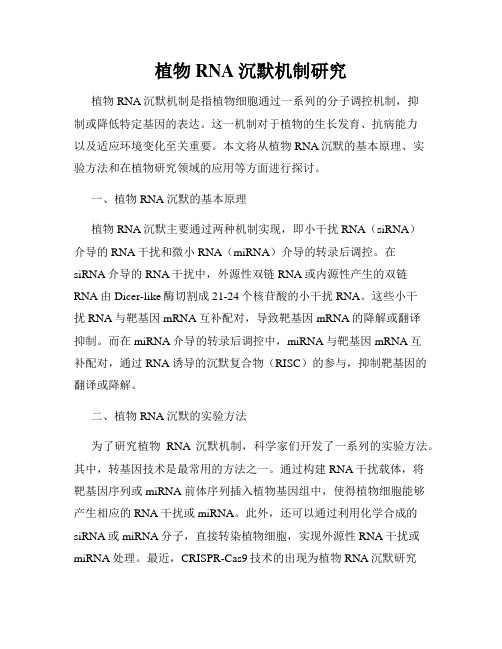
植物RNA沉默机制研究植物RNA沉默机制是指植物细胞通过一系列的分子调控机制,抑制或降低特定基因的表达。
这一机制对于植物的生长发育、抗病能力以及适应环境变化至关重要。
本文将从植物RNA沉默的基本原理、实验方法和在植物研究领域的应用等方面进行探讨。
一、植物RNA沉默的基本原理植物RNA沉默主要通过两种机制实现,即小干扰RNA(siRNA)介导的RNA干扰和微小RNA(miRNA)介导的转录后调控。
在siRNA介导的RNA干扰中,外源性双链RNA或内源性产生的双链RNA由Dicer-like酶切割成21-24个核苷酸的小干扰RNA。
这些小干扰RNA与靶基因mRNA互补配对,导致靶基因mRNA的降解或翻译抑制。
而在miRNA介导的转录后调控中,miRNA与靶基因mRNA互补配对,通过RNA诱导的沉默复合物(RISC)的参与,抑制靶基因的翻译或降解。
二、植物RNA沉默的实验方法为了研究植物RNA沉默机制,科学家们开发了一系列的实验方法。
其中,转基因技术是最常用的方法之一。
通过构建RNA干扰载体,将靶基因序列或miRNA前体序列插入植物基因组中,使得植物细胞能够产生相应的RNA干扰或miRNA。
此外,还可以通过利用化学合成的siRNA或miRNA分子,直接转染植物细胞,实现外源性RNA干扰或miRNA处理。
最近,CRISPR-Cas9技术的出现为植物RNA沉默研究带来了新的突破。
通过CRISPR-Cas9技术,可以针对特定基因进行基因组编辑,进而研究该基因对植物RNA沉默的影响。
三、植物RNA沉默在植物研究领域的应用植物RNA沉默在植物研究领域有着广泛的应用。
首先,通过靶向特定基因的RNA沉默,可以研究该基因在植物生长发育、信号转导、逆境胁迫以及植物抗病能力等方面的功能与调控机制。
其次,植物RNA沉默技术也被用于植物基因工程领域。
例如,通过抑制植物中的某个基因的表达,可以增加植物的抗虫能力或者改善植物的农艺性状。
rna沉默名词解释
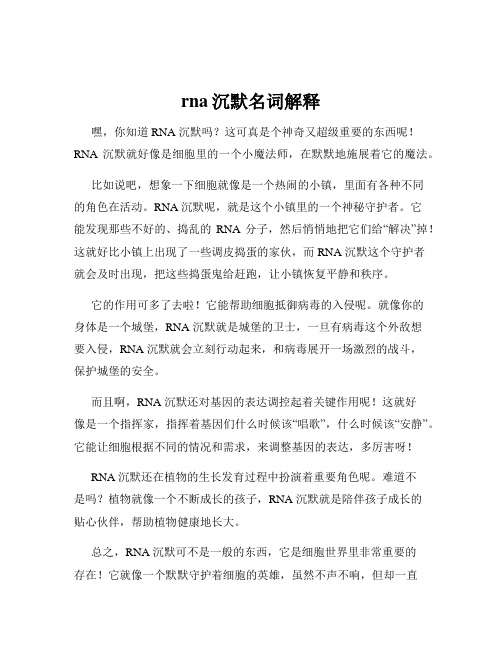
rna沉默名词解释
嘿,你知道 RNA 沉默吗?这可真是个神奇又超级重要的东西呢!RNA 沉默就好像是细胞里的一个小魔法师,在默默地施展着它的魔法。
比如说吧,想象一下细胞就像是一个热闹的小镇,里面有各种不同
的角色在活动。
RNA 沉默呢,就是这个小镇里的一个神秘守护者。
它
能发现那些不好的、捣乱的RNA 分子,然后悄悄地把它们给“解决”掉!这就好比小镇上出现了一些调皮捣蛋的家伙,而 RNA 沉默这个守护者
就会及时出现,把这些捣蛋鬼给赶跑,让小镇恢复平静和秩序。
它的作用可多了去啦!它能帮助细胞抵御病毒的入侵呢。
就像你的
身体是一个城堡,RNA 沉默就是城堡的卫士,一旦有病毒这个外敌想
要入侵,RNA 沉默就会立刻行动起来,和病毒展开一场激烈的战斗,
保护城堡的安全。
而且啊,RNA 沉默还对基因的表达调控起着关键作用呢!这就好
像是一个指挥家,指挥着基因们什么时候该“唱歌”,什么时候该“安静”。
它能让细胞根据不同的情况和需求,来调整基因的表达,多厉害呀!
RNA 沉默还在植物的生长发育过程中扮演着重要角色呢。
难道不
是吗?植物就像一个不断成长的孩子,RNA 沉默就是陪伴孩子成长的
贴心伙伴,帮助植物健康地长大。
总之,RNA 沉默可不是一般的东西,它是细胞世界里非常重要的
存在!它就像一个默默守护着细胞的英雄,虽然不声不响,但却一直
在为细胞的健康和正常运作努力着。
所以呀,可千万不能小瞧了 RNA 沉默这个神奇的小玩意儿哦!
我的观点就是:RNA 沉默是一个极其重要且充满奥秘的生物学现象,值得我们深入研究和探索,它为我们理解生命的奥秘打开了一扇新的大门。
94分Nature子刊综述:RNA沉默在病毒和非病毒植物免疫以及抗病系统之间的串扰中的作用
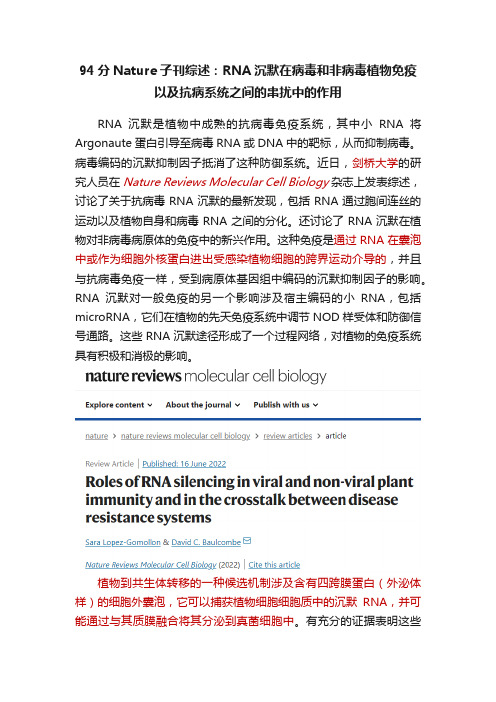
94分Nature子刊综述:RNA沉默在病毒和非病毒植物免疫以及抗病系统之间的串扰中的作用RNA沉默是植物中成熟的抗病毒免疫系统,其中小RNA将Argonaute蛋白引导至病毒RNA或DNA中的靶标,从而抑制病毒。
病毒编码的沉默抑制因子抵消了这种防御系统。
近日,剑桥大学的研究人员在Nature Reviews Molecular Cell Biology杂志上发表综述,讨论了关于抗病毒RNA沉默的最新发现,包括RNA通过胞间连丝的运动以及植物自身和病毒RNA之间的分化。
还讨论了RNA沉默在植物对非病毒病原体的免疫中的新兴作用。
这种免疫是通过RNA在囊泡中或作为细胞外核蛋白进出受感染植物细胞的跨界运动介导的,并且与抗病毒免疫一样,受到病原体基因组中编码的沉默抑制因子的影响。
RNA沉默对一般免疫的另一个影响涉及宿主编码的小RNA,包括microRNA,它们在植物的先天免疫系统中调节NOD样受体和防御信号通路。
这些RNA沉默途径形成了一个过程网络,对植物的免疫系统具有积极和消极的影响。
植物到共生体转移的一种候选机制涉及含有四跨膜蛋白(外泌体样)的细胞外囊泡,它可以捕获植物细胞细胞质中的沉默RNA,并可能通过与其质膜融合将其分泌到真菌细胞中。
有充分的证据表明这些囊泡与真菌细胞膜融合,它们在植物防御中发挥作用:四跨膜蛋白突变体(tet8和tet9)对真菌感染高度敏感。
HIGS介导的sRNA对核酸酶处理具有抗性,但对去污剂和核酸酶的联合处理不具有抗性,这与sRNA与细胞外囊泡的结合是一致的。
然而,对囊内货物更严格的测试是对核酸酶和蛋白酶处理的抗性。
基于这一严格测试的最新证据表明,HIGS介导的RNA在囊外,富含修饰N6-甲基腺嘌呤,并与N6-甲基腺嘌呤结合的GLYCINE-RICHRNA-BINDINGPROTEIN7(GRP7)和AGO2复合。
在这个阶段,我们应该对存在多种运输机制的可能性保持开放的态度,避免对哺乳动物囊泡运输进行复杂研究的陷阱。
RNA沉默在分析植物基因功能方面的研究
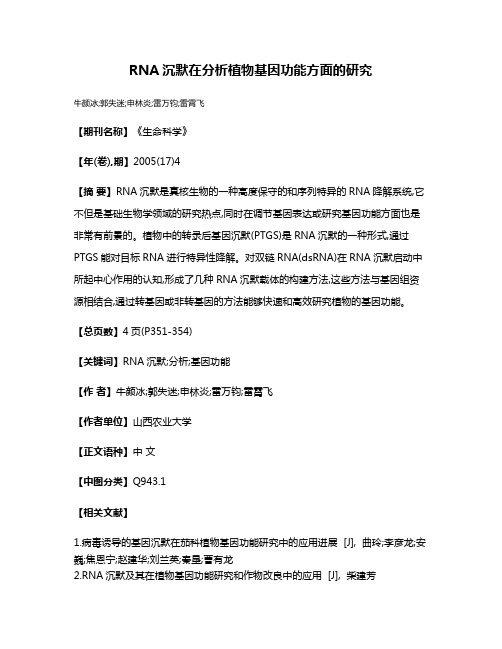
RNA沉默在分析植物基因功能方面的研究
牛颜冰;郭失迷;申林炎;雷万钧;雷霄飞
【期刊名称】《生命科学》
【年(卷),期】2005(17)4
【摘要】RNA沉默是真核生物的一种高度保守的和序列特异的RNA降解系统,它不但是基础生物学领域的研究热点,同时在调节基因表达或研究基因功能方面也是非常有前景的。
植物中的转录后基因沉默(PTGS)是RNA沉默的一种形式,通过PTGS能对目标RNA进行特异性降解。
对双链RNA(dsRNA)在RNA沉默启动中所起中心作用的认知,形成了几种RNA沉默载体的构建方法,这些方法与基因组资源相结合,通过转基因或非转基因的方法能够快速和高效研究植物的基因功能。
【总页数】4页(P351-354)
【关键词】RNA沉默;分析;基因功能
【作者】牛颜冰;郭失迷;申林炎;雷万钧;雷霄飞
【作者单位】山西农业大学
【正文语种】中文
【中图分类】Q943.1
【相关文献】
1.病毒诱导的基因沉默在茄科植物基因功能研究中的应用进展 [J], 曲玲;李彦龙;安巍;焦恩宁;赵建华;刘兰英;秦垦;曹有龙
2.RNA沉默及其在植物基因功能研究和作物改良中的应用 [J], 柴建芳
3.RNA沉默及其在植物基因功能研究和作物改良中的应用 [J], 柴建芳
4.RNA干扰技术在植物线虫基因功能研究及虫害防治方面的应用 [J], 王高峰;冯欣;彭德良;孙建华
5.RNA沉默及其在基因功能研究中的应用 [J], 彭昊;路铁刚;贾士荣;黄大昉
因版权原因,仅展示原文概要,查看原文内容请购买。
RNA干扰技术在植物病害抵抗中的应用
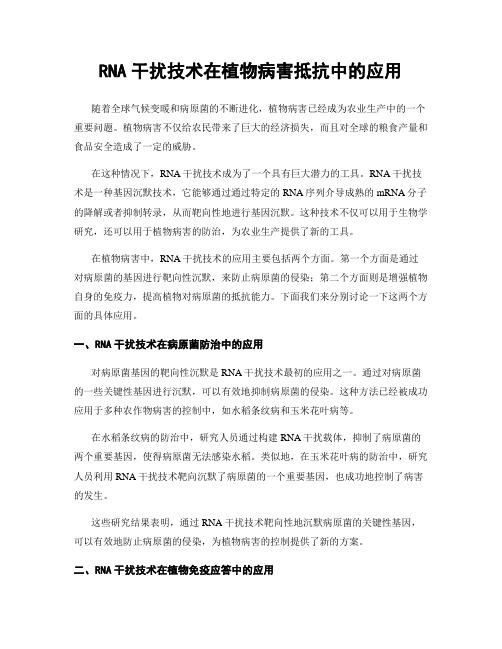
RNA干扰技术在植物病害抵抗中的应用随着全球气候变暖和病原菌的不断进化,植物病害已经成为农业生产中的一个重要问题。
植物病害不仅给农民带来了巨大的经济损失,而且对全球的粮食产量和食品安全造成了一定的威胁。
在这种情况下,RNA干扰技术成为了一个具有巨大潜力的工具。
RNA干扰技术是一种基因沉默技术,它能够通过通过特定的RNA序列介导成熟的mRNA分子的降解或者抑制转录,从而靶向性地进行基因沉默。
这种技术不仅可以用于生物学研究,还可以用于植物病害的防治,为农业生产提供了新的工具。
在植物病害中,RNA干扰技术的应用主要包括两个方面。
第一个方面是通过对病原菌的基因进行靶向性沉默,来防止病原菌的侵染;第二个方面则是增强植物自身的免疫力,提高植物对病原菌的抵抗能力。
下面我们来分别讨论一下这两个方面的具体应用。
一、RNA干扰技术在病原菌防治中的应用对病原菌基因的靶向性沉默是RNA干扰技术最初的应用之一。
通过对病原菌的一些关键性基因进行沉默,可以有效地抑制病原菌的侵染。
这种方法已经被成功应用于多种农作物病害的控制中,如水稻条纹病和玉米花叶病等。
在水稻条纹病的防治中,研究人员通过构建RNA干扰载体,抑制了病原菌的两个重要基因,使得病原菌无法感染水稻。
类似地,在玉米花叶病的防治中,研究人员利用RNA干扰技术靶向沉默了病原菌的一个重要基因,也成功地控制了病害的发生。
这些研究结果表明,通过RNA干扰技术靶向性地沉默病原菌的关键性基因,可以有效地防止病原菌的侵染,为植物病害的控制提供了新的方案。
二、RNA干扰技术在植物免疫应答中的应用除了直接靶向性地沉默病原菌基因外,RNA干扰技术还可以通过增强植物自身的免疫力来提高植物对病原菌的抵抗能力。
在植物的免疫系统中,小RNA分子起到了重要的调节作用。
通过对植物中的这些小RNA分子进行靶向性沉默,可以影响植物的免疫应答,从而提高植物对病原菌的抵抗力。
例如,在西红柿的抗病育种中,研究人员利用RNA干扰技术靶向性沉默了某些小RNA分子,成功地提高了西红柿对病原菌的抵抗力。
RNA介导的基因沉默技术在生物学研究中的应用
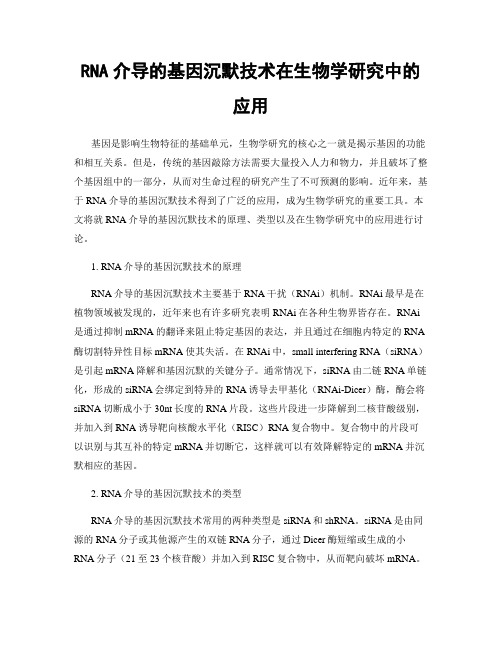
RNA介导的基因沉默技术在生物学研究中的应用基因是影响生物特征的基础单元,生物学研究的核心之一就是揭示基因的功能和相互关系。
但是,传统的基因敲除方法需要大量投入人力和物力,并且破坏了整个基因组中的一部分,从而对生命过程的研究产生了不可预测的影响。
近年来,基于RNA介导的基因沉默技术得到了广泛的应用,成为生物学研究的重要工具。
本文将就RNA介导的基因沉默技术的原理、类型以及在生物学研究中的应用进行讨论。
1. RNA介导的基因沉默技术的原理RNA介导的基因沉默技术主要基于RNA干扰(RNAi)机制。
RNAi最早是在植物领域被发现的,近年来也有许多研究表明RNAi在各种生物界皆存在。
RNAi 是通过抑制mRNA的翻译来阻止特定基因的表达,并且通过在细胞内特定的RNA 酶切割特异性目标mRNA使其失活。
在RNAi中,small interfering RNA(siRNA)是引起mRNA降解和基因沉默的关键分子。
通常情况下,siRNA由二链RNA单链化,形成的siRNA会绑定到特异的RNA诱导去甲基化(RNAi-Dicer)酶,酶会将siRNA切断成小于30nt长度的RNA片段。
这些片段进一步降解到二核苷酸级别,并加入到RNA诱导靶向核酸水平化(RISC)RNA复合物中。
复合物中的片段可以识别与其互补的特定mRNA并切断它,这样就可以有效降解特定的mRNA并沉默相应的基因。
2. RNA介导的基因沉默技术的类型RNA介导的基因沉默技术常用的两种类型是siRNA和shRNA。
siRNA是由同源的RNA分子或其他源产生的双链RNA分子,通过Dicer酶短缩或生成的小RNA分子(21至23个核苷酸)并加入到RISC复合物中,从而靶向破坏mRNA。
shRNA是单链RNA链的转录产物,其结构与siRNA类似,但是通常包含一个延长文档和多个loop和stem区域,便于对激活细胞的持续抑制。
3. RNA介导的基因沉默技术可以在各个方面应用于生物学研究。
RNA干扰技术在植物保护中的应用研究

RNA干扰技术在植物保护中的应用研究随着全球人口的增长和经济的发展,食品安全成为了人们关心的热点问题之一。
在农业生产中,病虫害侵害导致的作物减产和经济损失已经成为了全球性的难题。
因此,如何保护植物健康,提高农产品质量,是需要解决的问题之一。
而RNA干扰技术作为一项新兴的分子生物学技术,正逐渐在植物保护领域被人们所关注和应用。
RNA干扰技术是一种被普遍运用的基因沉默技术。
它利用双链RNA分子识别靶基因的同源序列,从而引导RNA酶将靶基因mRNA序列特异性降解,达到靶基因沉默的效果。
在植物保护中,RNA干扰技术应用的主要方式是利用RNA干扰的原理进行病害和虫害的治疗。
一种常见的RNA干扰技术是利用小干扰RNA(siRNA)介导靶蛋白质的mRNA的下调。
例如,植物病原真菌由于产生的一些二级代谢产物带有羟基化分子等特殊性质,因此难以针对这种有机物质去开发有效的杀真菌剂。
为此,潘建伟等人应用甜菜根瘤菌内生“T-DNA”中的RNA干扰技术对植物病原真菌进行有针对性的靶向抑制,展现了非常显著的杀真菌活性。
利用RNA干扰技术,不仅出现了抗真菌效果,而且比市场上所有的制剂都安全和环保。
RNA干扰技术还可以用于虫害防治。
例如,在利用RNA干扰技术精准靶向抑制昼夜节律相关基因,达到对害虫的高效植物保护的方法上也有一些研究,这种新型防治方法不仅能够显著减少化学农药的使用量,还能在保证农作物产量基础上实现环保效益。
当然,RNA干扰技术在植物保护领域尚存在一些问题需要解决。
例如,RNA干扰技术需要精确找到靶基因的同源序列,如果找错或忽略掉一些重要的靶基因,则会降低抑制效果。
同时,RNA干扰技术需要很少的双链RNA分子才能生效,如果样本富集程度不高或出现“噪声”信号,则可能引起对结果的干扰。
综上所述,RNA干扰技术是一种非常有效且环保的植物保护技术。
利用RNA 干扰技术可以减轻植物受到的病虫害危害,提高其抗性,从而进一步提高农产品的质量和数量。
RNA干扰技术在植物抗逆育种中应用观察

RNA干扰技术在植物抗逆育种中应用观察植物抗逆育种是一项重要的研究领域,旨在培育出能够在极端环境中生长并产生高产的植物品种。
在过去的几十年里,科学家们通过不断努力,在植物抗逆性方面取得了显著进展。
其中,RNA干扰技术是一种新兴的方法,已经在植物抗逆育种中展示出广阔的应用前景。
RNA干扰技术是一种通过选择性降解特定基因的mRNA分子来抑制目标基因表达的技术。
它通过介导RNA间接调控机体的基因表达,从而在抗逆育种中发挥作用。
这种技术是通过引入外源RNA分子(siRNA或miRNA)来干扰目标基因的表达。
这些外源RNA分子与目标基因的mRNA分子发生序列互补配对,从而激活RNA酶酶切系统,导致目标基因的降解或表达受到抑制。
在植物抗逆育种中,RNA干扰技术可以有效地抑制一些关键基因的表达,从而提高植物对逆境的耐受性。
例如,在面对干旱胁迫时,植物常常出现减水性失调和细胞膜受损。
通过干扰特定基因,如编码脱水素合成酶或蛋白质水解酶的基因,可以增加植物的水分利用效率和细胞膜的耐受性。
同样地,在盐碱胁迫条件下,通过RNA干扰技术抑制特定基因表达,植物可以积累更多的离子和抗氧化物质,从而提高耐盐碱能力。
除了干扰负面基因表达,RNA干扰技术还可以通过增强某些关键基因的表达来增强植物的抗逆性。
例如,通过转基因技术将调控积累抗氧化物质或调节离子通道活性的基因导入植物中,可以增加植物对胁迫的耐受性。
利用RNA干扰技术进行植物抗逆育种的一个关键问题是选择合适的靶标基因。
选择合适的靶标基因可以最大程度地提高抗逆性改良效果。
因此,先进的基因组学技术为植物抗逆育种中的基因筛选提供了有力的支持。
通过研究基因组序列和功能组学分析,可以确定潜在的靶基因,实现更加精准的基因编辑。
此外,反式遗传学和CRISPR-Cas9等技术的发展,也为选择和编辑合适的靶基因提供了新思路。
然而,虽然RNA干扰技术在植物抗逆育种中显示出巨大的潜力,但目前还存在一些挑战和限制。
植物中RNA干扰的生物学功能及其应用
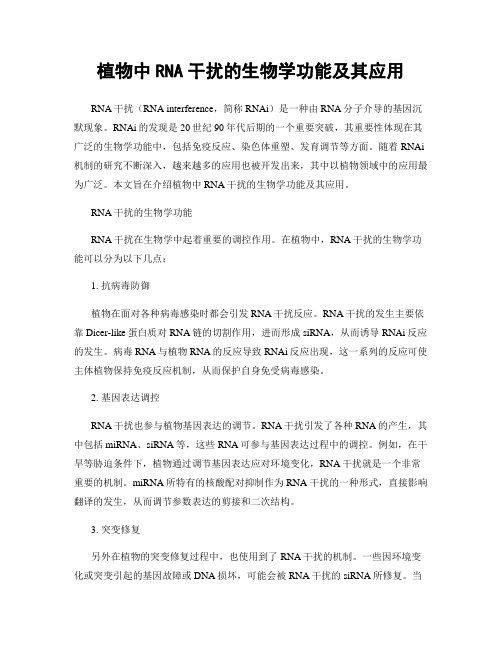
植物中RNA干扰的生物学功能及其应用RNA干扰(RNA interference,简称RNAi)是一种由RNA分子介导的基因沉默现象。
RNAi的发现是20世纪90年代后期的一个重要突破,其重要性体现在其广泛的生物学功能中,包括免疫反应、染色体重塑、发育调节等方面。
随着RNAi 机制的研究不断深入,越来越多的应用也被开发出来,其中以植物领域中的应用最为广泛。
本文旨在介绍植物中RNA干扰的生物学功能及其应用。
RNA干扰的生物学功能RNA干扰在生物学中起着重要的调控作用。
在植物中,RNA干扰的生物学功能可以分为以下几点:1. 抗病毒防御植物在面对各种病毒感染时都会引发RNA干扰反应。
RNA干扰的发生主要依靠Dicer-like蛋白质对RNA链的切割作用,进而形成siRNA,从而诱导RNAi反应的发生。
病毒RNA与植物RNA的反应导致RNAi反应出现,这一系列的反应可使主体植物保持免疫反应机制,从而保护自身免受病毒感染。
2. 基因表达调控RNA干扰也参与植物基因表达的调节。
RNA干扰引发了各种RNA的产生,其中包括miRNA、siRNA等,这些 RNA可参与基因表达过程中的调控。
例如,在干旱等胁迫条件下,植物通过调节基因表达应对环境变化,RNA干扰就是一个非常重要的机制。
miRNA所特有的核酸配对抑制作为 RNA 干扰的一种形式,直接影响翻译的发生,从而调节参数表达的剪接和二次结构。
3. 突变修复另外在植物的突变修复过程中,也使用到了RNA干扰的机制。
一些因环境变化或突变引起的基因故障或DNA损坏,可能会被RNA干扰的siRNA所修复。
当siRNA与神经节或RNAi工具相互作用后,干扰分子的作用需要滋补细胞核糖并与DNA结合,继而导致核酸产生特定的剪接并修复对DNA的损伤,从而使植物的基因絮凝在进化和适应环境的途径上得到修复。
RNA干扰的应用除了对生物学中的基础研究之外,RNA干扰在植物领域中的应用还包括:1. 基因沉默基因沉默是指通过RNA干扰沉默指定的基因。
- 1、下载文档前请自行甄别文档内容的完整性,平台不提供额外的编辑、内容补充、找答案等附加服务。
- 2、"仅部分预览"的文档,不可在线预览部分如存在完整性等问题,可反馈申请退款(可完整预览的文档不适用该条件!)。
- 3、如文档侵犯您的权益,请联系客服反馈,我们会尽快为您处理(人工客服工作时间:9:00-18:30)。
RNA沉默在植物逆境生物中的作用Abstract :Antimicrobial peptides, including defensins, are components of the innate immune system in ticks that have been shown to provide protection against both gram-negative and gram-positive bacteria. Varisin, one of the defensins identified in Dermacentor variabilis, was shown to be produced primarily in hemocytes but transcript levels were also expressed in midguts and other tick cells. In this research, we studied the role of varisin in the immunity of ticks to the gram-negative cattle pathogen,Anaplasma marginale. Expression of the varisin gene was silenced by RNA interference (RNAi) in which male ticks were injected with varisin dsRNA and then allowed to feed and acquire A. marginale infection on an experimentally-infected calf. Silencing expression of varisin in hemocytes, midguts and salivary glands was confirmed by real time RT-PCR. We expected that silencing of varisin would increase A. marginale infections in ticks, but the results demonstrated that bacterial numbers, as determined by an A. marginale msp4 quantitative PCR, were significantly reduced in the varisin-silenced ticks. Furthermore,colonies of A. marginale in ticks used for RNAi were morphologically abnormal from those seen in elution buffer injected control ticks. The colony shape was irregular and in some cases the A. marginale appeared to be free in the cytoplasm of midgut cells. Some ticks were found to be systemically infected with a microbe that may have been related to the silencing of varisin. This appears to be the first report of the silencing of expression of a defensin in ticks by RNAi that resulted in reduced A. marginale infections.引自: Katherine M. Kocan Æ Jose´ de la Fuente Æ Rau´ l Manzano-Roman ÆVictoria Naranjo ÆWayne L. Hynes ÆDaniel E. Sonenshine Silencing expression of the defensin, varisin, in male Dermacentor variabilis by RNA interference results in reduced Anaplasma marginale infections Exp Appl Acarol (2008) 46:17–28 DOI 10.1007/s10493-008-9159-5RNA 沉默在植物的逆境生理中具有重要作用,植物中已经发现了多种小RNAs, 如miRNAs 和siRNAs。
其中siRNAs 可以由外源性核酸产生, 如侵入的病毒, 这种外源性siRNAs 是植物、真菌和一部分动物重要的抗病毒机制。
siRNAs 也可以由植物自身基因组转录物产生, 如天然反义转录siRNAs (natsiRNAs)和长小干扰RNAs(long short interfering RNAs,lsiRNAs), 这些内源性siRNAs 和miRNAs 一样, 不仅可以调节植物基因表达, 而且在植物防御细菌和食草动物过程中也具有重要作用。
病毒或细菌则分别进化出了病毒沉默抑制子(Viral suppressors of RNA silencing, VSRs)或细菌沉默抑制子(Bacterial suppressors of RNA silencing, BSRs)在不同阶段抑制植物的RNA 沉默反应。
此外, miRNAs 或内源siRNAs 还可以和转录因子家族WRKY(Tryptophanarginine-lysine-tyrosine)相互作用, 参与植物的生物逆境胁迫反应, 本文就RNA 沉默在植物生物逆境反应中的作用机制、VSRs 和BSRs 的研究新进展做一概述。
1 植物参与RNA 沉默途径的主要蛋白质因子1.1 RNA 沉默的引发因子: Dicer-like 蛋白(Dicer-like proteins, DCLs)DCLs 可以认为是RNA 沉默的引发因子, 拟南芥(Arabidopsis thaliana L.)中有4 种DCLs: DCL1、DCL2、DCL3 和DCL4, 分别产生21 nt、22 nt、24 nt和21 nt-siRNAs。
DCLs 具有以下特点: (1) 功能冗余和互补, 如dcl3 发生突变时, siRNAs 可由DCL1、DCL2 和DCL4 剪切产生; (2) 作用过程中具有顺序性, 往往在dcl4 发生突变时, DCL2 才发挥功能[1]; (3)相互配合与协作, 在沉默花椰菜花叶病毒(CaMV)时,有多种DCLs 参与[2]。
在上述4 种DCLs 中, DCL1主要参与miRNAs 途径, 对(+)RNA 病毒siRNAs 积累贡献不大, 但可以利用发夹结构RNAs(hairpinRNAs, hpRNAs)为前体形成siRNAs[3]。
另外DCL1还参与nat-siRNAs[4]和lsiRNAs[5]的合成, 揭示DCL1 在防御DNA 病毒和细菌中具有重要作用。
但芜菁萎缩病毒感染拟南芥时, DCL1 可以负调节DCL4 和DCL3 表达, 影响植物抗性[6]。
DCL2 除了作为其他DCLs 的后备之外, 也涉及RNA 沉默转移性[7]及nat-siRNAs 合成[8]。
DCL3 多在转录水平发挥作用, 可使植物转座成分、重复序列或病毒DNA 发生甲基化修饰[9, 10], 也可在DCL4 上游发挥作用增强siRNAs 的积累[11]。
虽然现在还不知道长距离转运的RNA 沉默信号的本质, 但已经发现DCL3 参与这种沉默信号的接收过程[12]。
DCL4 是拟南芥防御病毒的主要DCLs, 因为病毒感染的细胞中往往21 nt-siRNAs 最多[10]。
此外, DCL4 还参与细胞对细胞的沉默信号的产生和接受[13], 长距离沉默信号的接受和次级siRNAs 的引物合成。
1.2 RNA 沉默的增强因子: 依赖RNA 的RNA 聚合酶(RNA dependent RNA polymerases, RDRs)RDRs 不仅能够产生次级siRNAs, 使RNA 沉默效应放大, 还可在RNA 沉默上游识别病毒, 也许病毒RNA 无帽子或无poly(A)的特点被RDRs 识别并引发RNA 沉默效应。
而生物自身有多种酶, 可防止自身正常mRNAs 进入RNA 沉默途径造成伤害[14]。
拟南芥中有6 种RDRs, RDR1 和RDR6 是防御病毒的主要RDRs, 其中RDR1 的表达可被水杨酸强烈诱导[11]。
烟草(Nicotiana rusticaL.)RDR1 则参与烟草防御食草动物的反应[15, 16]。
RDR6 不仅涉及转基因沉默、病毒防御、nat-siRNAs 合成、反式作用siRNAs (trans-acting siRNAs, ta-siRNAs)合成以及接受长距离沉默信号等[12], 还可以利用初级siRNAs剪切产物为模板,形成双链RNAs(double-stranded RNAs, dsRNAs), 参与烟草防御甘蓝菜曲叶病毒(CaLCuV)的反应[17]。
但类病毒可以利用RDR6, 以类似ta-siRNAs 的方式, 调节宿主的基因表达, 使植物产生病症[18]。
拟南芥RDR2 主要在转录水平调节基因表达或免疫DNA 病毒[9], 烟草RDR2 则可以调节酚类物质合成, 保护烟草免受氧胁迫或高UV 造成伤害[19]。
1.3 RNA 沉默的执行因子: Argonautes(AGOs)RNA 沉默中的小RNAs 往往要和AGOs 蛋白形成RNA 诱导的沉默复合体(RNA-induced silencing complex, RISC) 或转录沉默复合体(RNA-induced transcriptional silencing, RITS)来发挥作用。
拟南芥可以编码10 种AGOs, 其中AGO1 通过和miRNAs、siRNAs 和ta-siRNAs 形成复合物发挥作用, 拟南芥ago1 突变体对病毒高度敏感, 马铃薯卷叶病毒的P0蛋白[20]和黄瓜花叶病毒(Cucumber mosaic virus,CMV)的2b 蛋白[21]都可以通过AGO1 来抑制RNA沉默。
